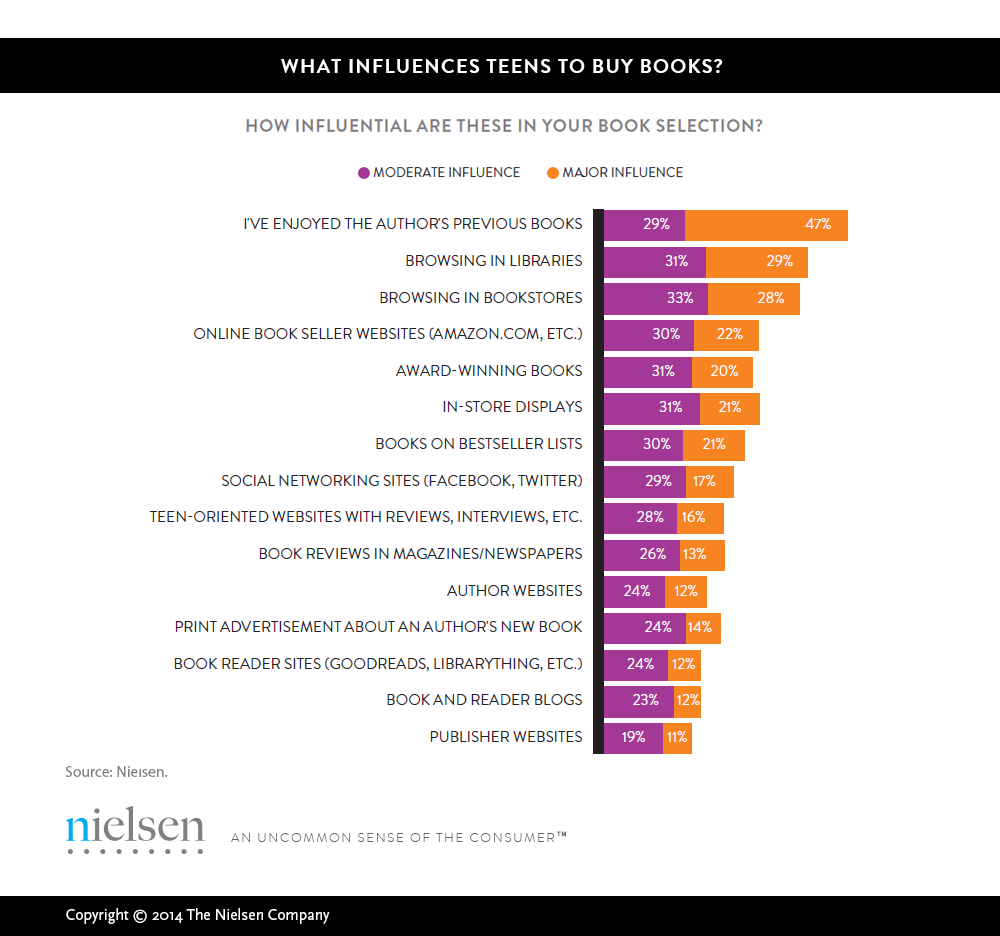With today’s rapidly evolving technology and ever-present social media changing the way consumers are connecting with the written word, it should come as no surprise that today’s teens are finding and consuming content differently from previous generations. But while we typically associate these youthful consumers with being early adopters of new technology and digital content platforms, the reading habits of those aged 13-17 are a mix of old and new.
Despite teens’ tech-savvy reputation, this group continues to lag behind adults when it comes to reading e-books, even with the young adult genre’s digital growth relative to the total e-book market. While 20% of teens purchasing e-books, 25% of 30-44 year olds and 23% of 18-29 year olds buy digital copies. While younger readers are open to e-books as a format, teens continue to express a preference for print that may seem to be at odds with their perceived digital know-how.
Several factors may play a role in teens’ tendency toward printed publications. Parents’ preference for print could have an effect or teens’ lack of credit cards for online purchases. But another explanation may be teens’ penchant for borrowing and sharing books rather than purchasing them, which is easier to do in print. Over half of teens are still looking for books on library or bookstore shelves. And in-store browsing is about level with browsing online for this group.
While teens might prefer reading traditional print, their paths to discovery are more dependent on word of mouth—and for today’s connected teens, this often means social media. Young readers are heavily influenced by what their peers are reading and what they’ve read before. Teens, especially teen girls, are more social about their reading compared to older generations, with 45% of teens at least moderately influenced by references to books on social network sites like Facebook and Twitter. And a similar 45% of teens are at least moderately influenced by teen-oriented websites containing reviews and author interviews.
Series especially benefit from the bandwagon effect social media can create. The biggest single source of influence for teen readers is enjoying an author’s previous books. So while authors and publishers have a challenge trying to hook a teen reader in the first time, they’ll likely have an easier time getting them to stick with that author.

While many teens still prefer print, these young readers are keeping publishers concerned, as the level of teenagers reading for pleasure has slowed down in recent years. In addition to the competition from other media and devices such as smartphones and gaming systems, the industry has also blamed the declines on the lack of recent blockbuster young adult novels such as the Twilight, Harry Potter and Hunger Games series. However, publishers eager to promote young adult literature might do well to look beyond younger readers: So far in 2014, U.S. consumers over the age of 18 buy nearly 80% of young adult books, both print and digital.
For additional insight about young readers, join Nielsen for its Children’s Book Summit Dec. 12, 2014, in New York.
Methodology
Included in this article are insights from Nielsen’s Books and Consumers U.S. Survey, a monthly online survey of 6,000 book buyers selected from a nationally representative sample by age, gender and location representing approximately 180,000 book purchases per year, and Nielsen’s Understanding the Children’s Book Consumer in the Digital Age, a sample of 3,000 children’s book buyers from the Books and Consumer Survey (including parents and teens), fielded Fall 2011-Fall 2014. Surveys were conducted in English only. Book sales were sourced from Nielsen BookScan, which measures EPOS sales data supplied by retailers in 10 countries worldwide.



